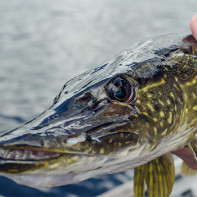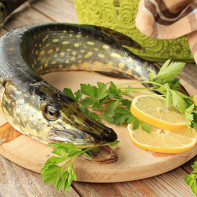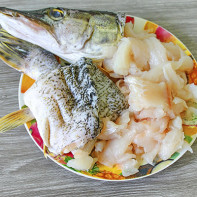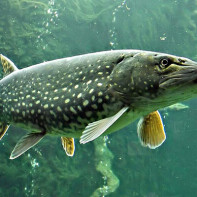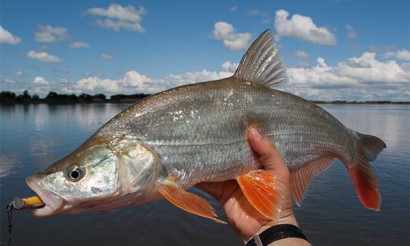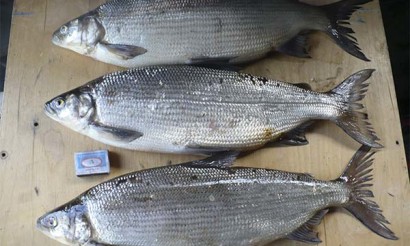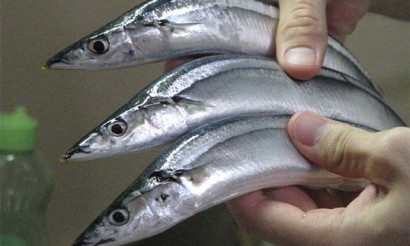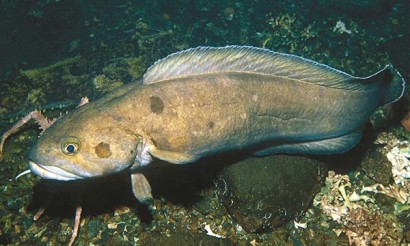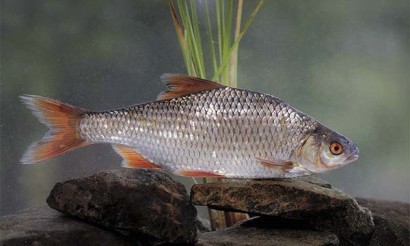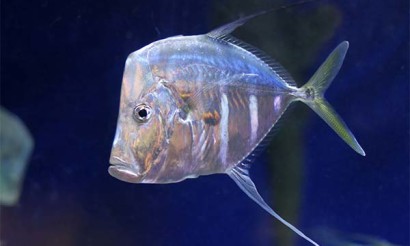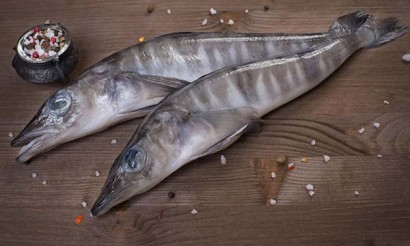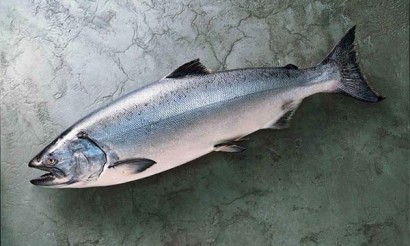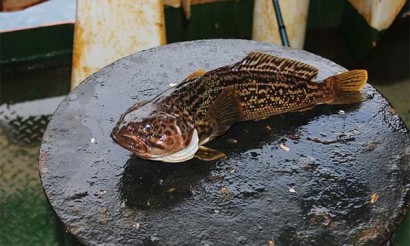Pike: photo, description, useful properties and recipes
Do not put your finger in her mouth - this is a popular folk expression, usually describing a predatory and grabby human personality, which may well be attributed to the pike. It is unlikely to bite your finger, but it can hurt you badly. This ruthless predator does not miss any of the fish living in the same water body as it - from gudgeon and roach to carp and bream. It can even swallow a prickly ruff, preliminarily clamping it with its jaws so that it loses the ability to flutter. Mice, frogs or even squirrels that happen to be on river or lake snags become the prey of the pike.
- Pike: what kind of fish, how it looks and where it is found
- Types
- Composition and calories
- Useful properties of pike
- General benefits
- For Women
- For Men
- In Pregnancy
- Breastfeeding
- For children
- Slimming down
- Is dried pike useful?
- How useful is pike roe
- How to salt
- Is it possible to eat pike liver
- People medicine application of pike
- Can we eat pike for various diseases
- Diabetes Mellitus
- For pancreatitis
- Gastritis
- With gout
- Health Hazards and Contraindications
- How to choose and store
- How to cook pike properly
- How to cook Pike: Recipes
- In the oven
- In the frying pan
- In a multicooker
- On the grill
- On the grill
- What to cook with pike: Recipes
- Cutlets
- Uha
- Canned
- Balak
- How to pickle
- Interesting Facts
Pike: what kind of fish, how it looks and where it is found
You should not always question the speeches of passionate fishermen, telling that last weekend they caught a meter-long pike weighing 10 kg. This is quite normal and realistic size. There are individuals reaching 1.5 m and even 1 m 80 cm, and weighing 35 kg. But most often caught specimens weighing from 1 to 2 kg and 40-50 cm in length.
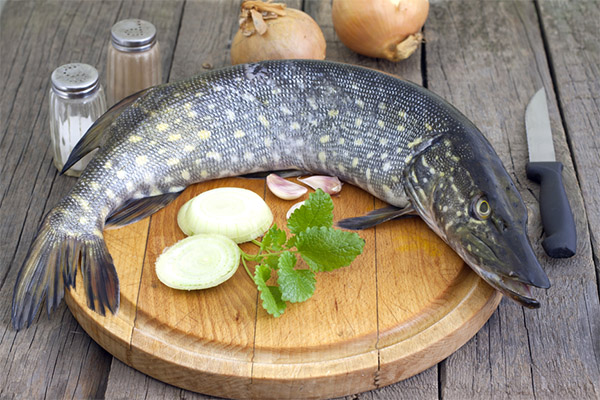
The body of pike is long, rather narrow and looks like both an arrow and a torpedo - due to the sharpened large head. The lower jaw protrudes further forward than the upper. The eyes are set rather high, and the huge mouth has up to three hundred sharp teeth. The largest, fang-like teeth are on the lower jaw. Although they vary in size, this predatory fish grips its prey quite firmly - so that the victim has almost no chance to escape.
The upper jaw is literally lined with small but equally sharp teeth, and all of them are pointed toward the throat, so that the prey can easily slip inside the mouth. To prevent the prey from slipping out, these teeth are able to lift and hold it tight. A fisherman's finger, carelessly caught in the pike's mouth, is sure to suffer.
But there are periods when the predator is not so "biting". It happens during the tooth change, when the old and sharp teeth have already dissolved, and the new ones are still soft. During this period, the pike can neither retain a large prey or catch a bait, so even the luckiest fisherman goes home without a catch.
The entire body of the pike is covered with fine and fairly dense scales, which can even go on the gills, and the coloring, or coloration, depends on the environment in which this freshwater fish lives. For the most part, it corresponds to the vegetation of a lake, pond or river and can be both gray-green and pure gray, as well as yellowish-gray or brown. Moreover, the darkest place is usually the back; on the sides the intensity of coloration decreases, but dark spots appear on them, merging into a striped pattern, and the abdomen may be generally light, almost white. Occasionally there are pike silver color, but they are caught quite rarely.
The upper dorsal fin is large and has a rounded shape. The lower anal fin is set far back, which increases the speed capabilities of the fish. These unpaired fins are usually the same color as the main body color - yellowish gray, brown or greenish gray, with darker spots. Pair of lower fins, located closer to the head, is usually tinged with orange.
Those who like to eat the eggs will certainly try to seek out the female. They are usually larger than males and differ from them by their urogenital opening in the form of an oval-shaped depression surrounded by a pink roller, while the male's opening is a narrow slit.
The most common habitats of the pike are lakes, ponds, and quarries. If a river - it is slow, lazy and quiet. This is a typical resident of freshwater reservoirs, and prefers not running, but standing water. Pike is caught throughout Russia and on the North American continent.
In the desalinated marine bays, it also occurs - somewhere near the inflowing rivers. It can be found near the Taganrog Bay of the Azov Sea, as well as in the Baltic Sea - in the Curonian, Riga and Finnish Bays. Experienced fishermen know that it is better to look for it in estuaries with sandy bottom or in quiet backwaters near the shore, where it ambushes its prey in algae, snags or natural holes and hollows on the bottom. However, the aquatic predator is very demanding to oxygen: if there is not enough of it in the water, pike die.
Species
In freshwater reservoirs, there are 5 species: common, American, maskinong, black (or striped) and Amur.
- Common. Habitual for residents of the former Soviet Union, found most often in Europe and Asia. It is also caught in North America.
- American. It is not as widespread as the American. It is found only in the east of the North American continent. In the northern regions of its range is found such a subspecies of American pike as red snapper (otherwise known as northern). To the south, the grass (or southern) subspecies reigns, its home being the Gulf of Mexico river basin, particularly the Mississippi.
- Maskinong. The largest and rather rare freshwater pike. Its habitat is North America. This raptor is silvery in color with dark, vertical stripes on its flanks.
- The black, or striped, predator. Inhabitant of lakes and quiet river backwaters throughout North America - from Canada to Florida. It is smaller than its other congeners and does not grow longer than 70-80 cm, while recorded its maximum weight - 4.3 kg. This fish has an attractive mosaic coloration.
- Amur. It can only be caught in eastern Russia - on Sakhalin, as well as in the rivers flowing into the Amur. It grows up to 1 m in length and may weigh up to 20 kg.
- Panzerfish. Deserves special attention. This is not a freshwater inhabitant, it can safely live in the sea, where it fattens up to 3 m. Inexperience, from a distance it may seem like a crocodile. She has a second name accordingly: Alligator fish. Is found in warm waters: in the Caribbean, on the coast of Cuba and Central America.
Composition and calories
The pike meat peculiarity is that it has absolutely no carbohydrates and only 2-3 % of fat, that is why doctors unanimously recognize it as a dietary product. But in 100 g of this fish there is almost half of the daily norm of phosphorus, 30% of selenium and a lot of manganese. The list of useful and even essential to the human body includes such components as magnesium, iodine, calcium, copper, fluorine, zinc, as well as copper, iron and cobalt.
The freshwater carnivore abounds in different B vitamins: B1, B2, B3 (PP), B5, B6, B9, B12, as well as A and C. In addition, pike is rich in protein, and it is much easier to digest than meat.
The caloric value of fish is low - only 82 kilocalories in 100 grams of product. But depending on the method of cooking calories can vary - so, boiled pike it increases to 98 kcal, fried - 127 kcal, and smoked - 162 kcal.
Useful properties of pike
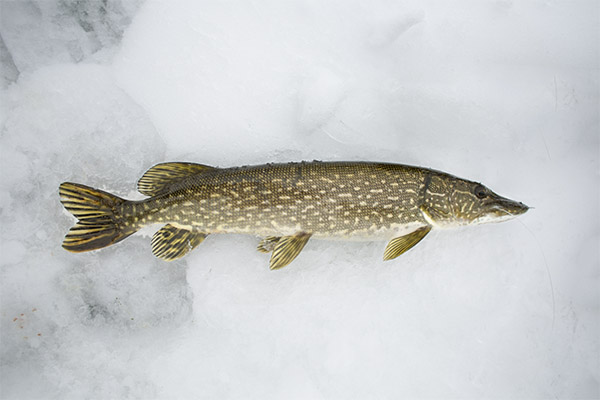
General health benefits
- Thanks to a large set of B vitamins, pike keeps the nervous system in order. These vitamins along with amino acids help control metabolism and hormones. The list of useful properties includes the ability to maintain normal insulin levels, so it is a means of preventing diabetes. Regular consumption of pike meat helps to reduce harmful cholesterol.
- Vitamins A, E, C are responsible for maintaining immune strength and normal skin and hair.
- Strengthening of bones and cardiovascular system is possible thanks to phosphorus and calcium, and iodine is responsible for the functioning of the thyroid gland.
- Useful proteins contribute to the relief of patients with digestive system diseases, because they are digested quickly and easily.
For women
For women, pike is interesting, first of all, as a tasty product that allows you to extend the beauty and youth. Thanks to the presence of phosphorus, calcium and fatty acids, nails are strengthened, hair becomes smoother and silkier, and the skin is firmer. Magnesium contained in pike meat helps to calm the nerves and normalize sleep.
For men
For men pike is useful in terms of beneficial effects on the heart and blood vessels, delaying a dangerous heart attack for the stronger sex. In addition, due to the low fat content, along with the presence of protein, it helps build muscle mass. And pike roe increases libido and improves the ability to conceive.
Pregnancy
Pregnant women need fish because it contains calcium, phosphorus and proteins necessary for the formation of bones, teeth and other organs of the baby. And potassium and magnesium, which are available in pike, are needed by the future mother herself, as it allows to reduce the risk of muscle cramps, which often appear in the final stages of pregnancy. But abuse pike pregnant women do not need, you can eat it 2-3 times a week.
When breastfeeding
If the mother ate pike during pregnancy and did not experience any discomfort, it is possible during breastfeeding not to deny herself this pleasure. For the growing baby's body and the formation of his strong skeleton needs the calcium, phosphorus, vitamins and proteins that fish contains. It is important that the child is not allergic. So try to introduce pike in the diet of a nursing mother should be careful, in small portions, watching how it reacts to the body of the crumb.
Most likely, if the mother ate this fish during pregnancy, the child is familiar with the product, so there should be no problems.
For children
Any fish is useful for children, and pike, given its low fat content, especially. But you should be wary of allergic reactions. Therefore, pike should be placed on the children's table not earlier than the baby is one year old. It is recommended to boil the pike fillet, grind it with a blender and strain it with a sieve so as not to miss the smallest bones. The first times it is better to mix the fish with mashed potatoes or vegetables. To begin with, do not give more than half a teaspoon and watch for skin manifestations.
If the child's body reacts well to the fish, then from a year and a half you can include pike cakes in his diet.
When losing weight
Since pike has low calories and contains many different vitamins, it is well suited for dietary nutrition. The ability to have a beneficial effect on the work of the digestive system allows you to improve the metabolism. That is why nutritionists strongly recommend pike as one of the mandatory components of dietary weight loss. Of course, those who have decided to stop being overweight should not eat salted, fried, smoked fish or canned fish. It is better to eat boiled, baked or stewed dishes.
Is dried pike healthy?
Undoubtedly, dried pike contains the whole set of useful substances, so it could be considered a healthy product, recommended for the diet of every person, if it were not for the excessive amount of salt used in the cooking process. Therefore, for those who suffer from kidney disease, cardiovascular system and pathologies associated with metabolic disorders, it is better to stew or boil pike - the benefits will be greater.
In addition, if the technological chain of cooking dried pike is violated, there is a great risk of contracting worms. Among those helminths, the larvae of which infect fish quite often, are broad lepidoptera. If such larvae end up in human intestines, they will develop into a large adult (up to 20 m) specimen. The bearer of this huge parasite may for several years not even realize who he sheltered in his own body. Therefore, it is better to subject pike to heat treatment. Or to prepare products from it after a long (up to 12 hours) freezing.
How useful is the caviar of pike
Both physicians and gourmets put pike roe in the third place - after black and red. It contains a minimum amount of fat, but is rich in proteins, trace elements and vitamins - this is what is needed for a dietary diet.
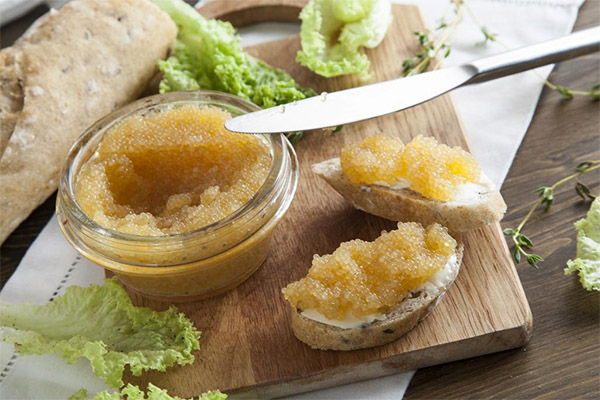
Those who often eat pike roe note that their blood pressure stabilizes, and previously low hemoglobin is restored to normal numbers. Thanks to the presence of amino acids, caviar increases the body's immune system, and vitamins A and E contained in caviar prevent premature aging: they stimulate skin cell regeneration, rejuvenate it, purify it and make it firmer and more beautiful. Caviar also nourishes hair and nails and improves their condition and appearance.
This product is also useful for improving brain function and reducing the risk of atherosclerosis, as the body is cleared of excess cholesterol, which is facilitated by the omega-3 fatty acid. Due to its high iodine content, it has a positive effect on the thyroid gland, which allows a person to feel a burst of energy and strength. Caviar helps people recover from serious illness or surgery and pregnant women.
How to salt
At home, caviar is salted in two ways - hot and cold.
Cold method
Caviar washed, cut into pieces 2-2.5 cm long and only then cleaned from the ovary (film): a fork to pick up the edge of the foil and gently move it to the side. Peeled caviar put in a deep bowl. When all the product is clean, pour warm water over it and stir with a pastry whisk. The film, which did not succumb to the fork and remained on the caviar, will wrap around the whisk.
In this way wash the caviar 3 times, gently draining the water. At the end of the process, cover the colander with gauze and pour the contents of the bowl into it. When all the water has drained away (it will take about 20-30 minutes), the caviar to transfer to a bowl, add salt (preferably coarse) and mix well with a fork - until the foam appears. For 300 g of caviar need 2 tablespoons of salt.
Take off the foam - you can not remove all of it, but you have to try to do it as much as possible. Put the caviar in a jar, close the lid and leave for two days in the refrigerator. During this time, the caviar will salinate, and the rest of the foam will go away. The finished product will become thicker and take on a beautiful hue.
Perhaps some people may find caviar a little salty, but you can not take less salt, you need to rid the product of parasites. And for a sandwich with butter, this degree of salinity is quite suitable.
The hot method
Prepare the caviar in the same way as for cold salting. Let the rest of the water drain off through gauze and a colander. Meanwhile, prepare the brine: bring 1 liter of water to a boil with 2 tablespoons of salt, cool it for about 10 minutes and pour the caviar put into a jar. Thoroughly mix the caviar with the brine and leave for a quarter of an hour, after which the excess fluid drain with gauze and colander. Add 1.5-2 spoons of vegetable oil and whisk until it thickens. In 6-7 hours it is already possible to eat it. Caviar obtained in this way is slightly lighter than that cooked in the cold way, and less salty. But there is no need to fear parasites: the caviar is neutralized by soaking in hot brine.
Is it possible to eat pike liver
Pike liver is rich in substances that are extremely necessary for the human body. For example, 100 g of the product contains half of the daily necessary amount of phosphorus responsible for metabolism and the state of the bone and cardiovascular systems, and almost 40% of the daily norm of riboflavin (vitamin B2), which contributes to soothing the central nervous system, supports the normal state of skin, hair and nails, stimulates the breakdown of fats, proteins and carbohydrates.
Vitamin PP in 100 grams of liver is a quarter of the daily norm, and without it normal human brain activity and vision is unthinkable. In addition, this vitamin is involved in regulating cholesterol and blood sugar levels, lowering blood pressure and improving the blood supply. The task of improving blood circulation is also performed by iron, which is also a component of the liver. It also helps maintain the human immune system.
That is, pike liver is useful, it helps people to be more active, healthy, energetic and keep in order as vision, skin and hair, as well as the work of internal organs. And thanks to its low caloric content (131 kcal per 100 grams of product) it can be used as a component of a weight-loss diet. In stewed or boiled form, without extra salt, it can be eaten even by people suffering from diabetes, peptic ulcers, and pregnant women. The only contraindication can be an individual intolerance of liver or an allergic reaction to fish products.
Pike liver is cooked with sour cream or vegetables, cream or herbs. It can be stewed, stewed in the oven or cooked on the stove, it is possible to cook it in a microwave oven or multipacker. It is more tender than even cod liver. It can be served both hot and cold, with a side dish or in salads, as pâté, spread on a sandwich.
The use of pike in folk medicine
Folk medicine has long known about the beneficial properties of pike meat. However, modern patients may find it strange how the ancient healers used the fish for treatment - for example, dripping its bile into the eyes. There was a belief that this way you can cure leukemia. And tying a live pike to the stomach was unlikely to cure jaundice, although this method was widespread.
But some folk recipes really work and are quite suitable for use in modern life. So, if the pancreas is a little "fussy", veduns recommend to eat on an empty stomach a small piece of boiled pike (100 grams).
Vitamins in this fish, contribute to a speedy recovery from anemia and avitaminosis, and thanks to its constituent proteins normalizes the work of the thyroid gland. Besides, if during the season of flu and colds you systematically include pike in your menu, you can protect yourself from the disease.
Folk medicine recommends fish also for those who have signs of chronic fatigue syndrome or depression. Healers know that regular consumption of pike meat or its other products (liver, caviar) can restore a person's interest in life, improve health.
Is it possible to eat pike for various diseases
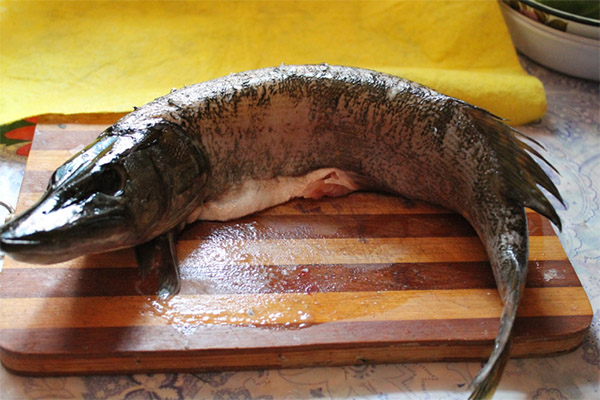
For diabetes mellitus
People suffering from diabetes, pike meat is strongly recommended. Easily digestible proteins (proteins) in it a sufficient amount, it is completely free of carbohydrates, which is exactly what diabetics need. Protein helps the body to synthesize its own insulin, and contained in the fish potassium, magnesium, phosphorus and calcium are actively involved in the metabolic process, helping to regulate it, as well as support the heart and blood vessels.
Dieticians do not recommend overloading the body with fish products and advise eating pike no more than a couple of times a week - no more than 150 grams a day.
Diabetic patients should eat pike baked, stewed or boiled. Cutlets, casseroles, and casseroles are also good. Salted or dried fish should not be eaten, and neither should pike liver. Caviar can be eaten occasionally and in minimal quantities.
For patients with diabetes, baked vegetables, fruit, sauces, and bread are ideal for fish.
In pancreatitis
Pike refers to lean types of fish, the fat content of which does not exceed 4%, so doctors and nutritionists recommend it to patients suffering from pancreatitis. The proteins in fish are much easier and better absorbed than animal protein. Due to the content of amino acids, iodine, phosphorus, calcium, B vitamins and other components, pike meat adds variety to the diet and enriches the dietary diet. True, you can start eating fish only a week after the acute attack of the disease.
At first it is best to cook pike on steam and only in the ground form. You can grind as a cooked product to get souffles, and make minced raw cutlets or casseroles in the steamer. To fish it is recommended to serve either porridges or non-vegetables, recommended by the doctor for pancreatitis.
Fish can be eaten baked or boiled as a whole piece, not earlier than a month after the attack. Moreover, fish broths and soups based on them are not recommended for pancreatitis. Salted, smoked or dried pike, as well as canned fish are also forbidden.
With gastritis
For the stomach, pike is useful and convenient because it is easily digested. Since its fat content does not exceed 4%, it is recommended for patients suffering from gastritis. Thanks to the useful substances included in the composition of pike meat, this fish is able not only to stimulate the work of defenses, but also to remove excessive cholesterol and fill the body with vitamins and minerals, the absorption of which is difficult with gastritis. In addition, the low fat content will not give the appearance of pain in the stomach, nausea and diarrhea.
But with gastritis, it is the way in which the fish is cooked that counts. It is strictly prohibited to eat fried, salted, pickled, smoked pike and canned fish, because preservatives, spices and salt strongly irritate the already inflamed gastric mucosa. Fish should be boiled, steamed or baked without adding oil.
If you have gout
Gout is characterized by deposits of uric acid salts in the joints. Therefore, it is important for patients with gout to exclude from the menu foods that are rich in purines - compounds, as a result of the destruction of which is formed by the notorious uric acid. Fish contains such substances, but in different amounts. Therefore, nutritionists divide all fish into those that are banned for gout, and those that are allowed. Pike belongs to the permitted group. But even such fish can be eaten not more than 3 times a week.
For gout, pike should be either boiled or baked, you can cook cutlets or meatballs on steam. It is also allowed to use ukha, but it should be cooked on the second broth, and the first one should be poured off, since it is too greasy. No spices should be used, and the amount of salt should be limited to a minimum.
To avoid the aggravation of gout, you can not eat pike with porridge, because in such a combination significantly increases the load on the stomach, as a result, the excretion of uric acid salts slows down.
Harms and contraindications
Despite all its beneficial properties, pike cannot be absolutely safe, as well as all fish grown and living in natural conditions. If the water in the reservoir, from where the predator was caught, is polluted, it will certainly affect the quality of pike - and its meat, and liver, and caviar, which will accumulate harmful substances. Such fish should not be eaten in any case, you can be poisoned - up to the failure of the internal organs. Therefore, it is better to catch pike in areas with favorable environmental conditions.
And even in the most environmentally friendly water pike infection with parasites is not excluded. They are killed during thermal treatment of the fish, but its dried or salted meat can be dangerous: if you eat a piece of it, helminthes get into the digestive system of humans and stay there for many years.
Salted or dried pike, even perfectly cooked, because of the excess salt is contraindicated to those who have kidney or heart disease, liver problems.
Allergies to fish or individual intolerance to pike can also take place. In such cases, the product in any form should be abandoned.
How to choose and store
There is no doubt that the best choice - to catch pike by yourself at a well-known, years-tested body of water: you can not fear that it has grown in adverse environmental conditions, and with its freshness everything is clear.
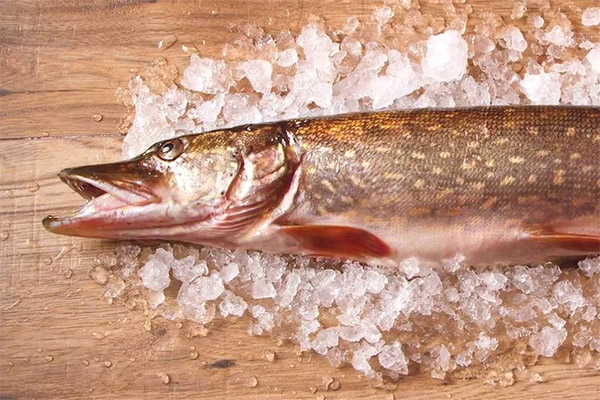
If you have to choose at the market or in a store, the first thing to do is to ask the seller where the pike comes from, and pay attention to its gills: when the fish is fresh it's pink and shiny. The eyes should be unclouded and clean, and the tail - moist.
The specific smell of pike (tina) is not to everyone's liking, but if the fish lying on the counter smells exactly like that, without the admixture of other smells, then it is fresh and worthy to be cooked for dinner.
Under the frozen pike can be hidden product that was lying on the counter for several days and not sold, that is not the first freshness. So it is better to take frozen fish as a last resort. But choose the one without ice on it: usually the extra ice tells that the product was repeatedly defrosted and then frozen.
If you have bought fresh pike it is better to wash, clean and gut it and only then put it either to the fridge or to the freezer. The fresh pike can keep in the refrigerator up to 4-5 days, in the freezer - up to half a year, but after a couple of months of storage its flavor properties begin to deteriorate.
How to clean a pike properly
Clean all dirt and mucus from the pike with a brush under running water, rinse it well and dry it with a cloth or paper towel. It is better to take a plastic or glass cutting board: wooden one will soak in the fish smell that it will be impossible to get rid of it later. Wet paper towels should be put under the board so that it does not slip and lies motionless.
Scales from pike fly far away, so it is better to clean it outside. If there is no such possibility, you should cover the surfaces nearest to the cutting board with newspaper. While cleaning the pike, one should hold its tail and sprinkle some salt on it so it won't slip out.
In order not to hurt yourself while working, you should wear two pairs of gloves: rubber or silicone ones first, and cotton ones on top of them.
The scales will be cleaned easier if the pike is scaled with boiling water. To facilitate the process, you can also soak it in a basin of warm water with added vinegar.
To clean a pike, either a wide sharp knife or a special scraper with teeth is suitable. The scales should be cleaned starting from the tail and moving towards the head. If you hold the knife at a slight angle, the scales will stay on the blade and less scatter.
When the scales are finished, use scissors to cut the fins and a sharp knife to cut the abdominal cavity, starting with a puncture near the head. Then take out the insides and remove the gills by cutting them with a knife or simply by tearing them off with your fingers.
When the cleaning is complete, rinse the entire carcass well - both outside and inside.
How to cook pike deliciously: recipes
In the oven
In the oven, you can cook pike as on a tray, and in a deep pan (it is important that the handle of it was not plastic). If you bake pike with vegetables or sour cream, it will be more juicy.
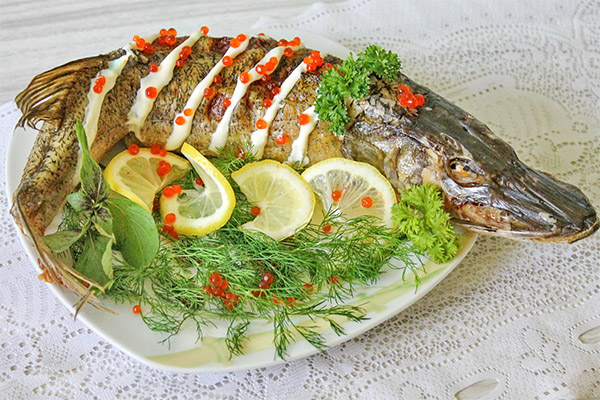
Pike with mixed vegetables
Cabbage, zucchini, tomatoes, eggplant, bell peppers, onions are good companions for pike. Eggplant is good only when it is young and must be stripped of its shiny purple skin.
The calculation of vegetables is based solely on the preferences of the cook and family members: someone likes more cabbage and can't stand zucchini, someone can't stand the smell of sweet peppers, but crazy about eggplant. So the proportions are in the hands of the hostess. The only caveat - carrots in this kind of cooking will not reach the right condition and will crunch.
Cut the vegetables into fairly large slices (or strips at least 1 cm wide), the onion - in quarters of rings. Mix them in a bowl and salt a little. Cut pike (preferably fillet) into pieces 3 to 4 cm wide.
Spread pieces of fish on a baking tray greased with vegetable oil (not close to each other, but so that there is room for vegetables), salt them. Then place the vegetables in between. Drizzle the contents of the baking tray with olive oil and lemon juice (a quarter of a lemon is enough), you can sprinkle with ground black pepper. Send the tray to the preheated oven. Cook fish with vegetables at 170-180 degrees for about 40-45 minutes. You get a full dinner, which does not require additional garnish. You can put chopped dill on each plate right on the table.
Pike in sour cream
For 1 kg of pike fillet take 3 tablespoons of sour cream, 2 medium-sized onions and spices to taste and taste.
Cut the filet into slices about 5-6 cm wide, put it in a pan with a slight splash of vegetable oil. On top put chopped half-ring onion, salt and sprinkle with spices (you can just mix pepper from a miller). Dilute the sour cream in equal parts with water and pour over the fish. You can send the pan to the oven. If it is already hot, the pike will be ready in 35-40 minutes.
In the pan
To make the pan pike turn out not dry, but juicy, you need to take a lot of onions for cooking - half the weight of the fish.
Cleaned gutted pike cut into portions, put them in a bowl, pepper and salt. While the fish is slightly salting, prepare a frying pan (preferably heavy, cast-iron) and pour into a bowl of flour for deboning.
Put the frying pan on the stove, pour the odorless sunflower oil into it and wait until it is well heated. Only then coat the pike in flour and put it out to fry. Do not put the lid on yet!
When on the bottom side there is a beautiful crust, to turn the fish over, put chopped onion with half rings and only now put a lid on it. From time to time lift the lid and stir the onions. A couple of minutes before cooking, put a couple of small slices of butter into the pan. Serve the pike with tender mashed potatoes and fresh vegetable salad.
In the multicooker
In the multicooker it is good to cook pike in a cheese sauce, for which 1 kg of pike fillet cut into portions, mix with the juice of one lemon, onion cut in quarters of rings, salt and sprinkle with your favorite spices. Leave it to marinate for 45-50 minutes. Grate 100g of hard cheese and mix it with 100g of fat sour cream. Put the fish and onions in a bowl of a multicooker, pour the sour cream and cheese sauce. Close the multicooker and set the mode "Fish", "Stew" for half an hour. At the end of the process, let the pike lie under a closed lid for another 15-20 minutes. It is better to eat such a dish hot.
On the grill
In hot coals, you can bake a pike with the use of foil. To begin with a clean gutted pike at least half an hour marinade: rub it on all sides with salt, juice of half a lemon and put in a bowl with the fish chopped rings of onion. After 30-40 minutes, spread the foil on the table, put on it half of the onion from the bowl, making a kind of "pillow", on which then lay the fish. In the belly of the pike put the lemon and dill cut into half rings - the more it will fit, the more fragrant the fish will be. On top of the carcass put the remaining half of the onion and carefully wrap in foil. The resulting envelope wrap in another layer of foil and place directly into the coals, making a hollow in them. On top of the foil roll also cover the hot coals. 25-30 minutes while the fish is cooking in the countryside will fly by unnoticed.
On the grill
To cook pike on the grill, it must first be marinated. Marinade prepare from the juice of half a lemon, 2 tablespoons of vegetable oil, ground black pepper and salt (to taste). This will be enough to cook 800 g of pike steaks. After half an hour from the start of marinating, place the steaks on a grill grate greased with vegetable oil. Cook until crispy, turning the grill from time to time. Such fish will go well with fresh vegetables, herbs and sauces.
What can be cooked of pike: Recipes
The first, second and appetizers - pike meat is good for everything. Dish from it can be served as a narrow home circle, and to indulge guests.
Cutlets
Cutlets can be made from fresh or boiled pike. In the first case, it is more difficult to get rid of all the small bones, but if the meat grinder is powerful enough, it can grind them. Pike cutlets are served with a side dish, mashed potatoes go especially well with them. Pike cutlets are "friendly" with fresh cucumber, so a salad will come in handy.
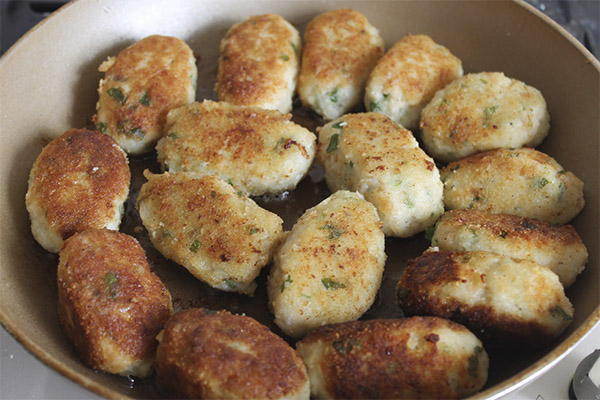
Fresh Pike Cutlets
Wash the pike from slime, clean it, remove the insides, wash again, cut off the head and fins and cut along the back. Separate the central bone, it together with the fins and the head will be useful for the soup. And from the remaining flesh try to select as much as possible the small bones, you can do this with tweezers or a reisfer. If you succeed, it is also better to remove the skin.
The resulting fillet is crushed through a meat grinder, along with the onion and a couple of cloves of garlic. Since the pike meat is a bit dry, you can add in the process of mincing a little unsalted pork fat: 1 kg of pike fillets piece the size of melted cheese. To make the cutlets more tender, mince them in a meat grinder again.
Mix the stuffing carefully, adding 2 eggs (1 kg of fish fillet). Season with salt and pepper to taste. Make patties from the minced meat, dip them in flour and fry on a hot griddle in vegetable oil.
If pork fat was not added to the mince, for greater juiciness put a small piece of butter (the size of half a teaspoon) inside each cutlet. Once the cutlets are fried on both sides until they are browned, pour some water into the frying pan and stew them for sure to protect yourself and your loved ones from parasite infestation.
If the cutlets are designed for dietary meals and additional fats in the form of lard or butter are excluded, you can add boiled medium-sized carrots to the mince in the process of cooking. It will add juiciness to the finished dish, and give it an interesting color.
Boiled pike cutlets
Clean pike, gut, wash, cut into large portions, put them in a large saucepan with water and put on the stove. When it boils, remove the foam and boil the fish until tender. Then remove from the stove, remove pieces of broth and cool. The broth can be used for soup.
The cooled fish is disassembled, separating it from the bones. It is very convenient to take out all the smallest bones from the cooked pike. Peel a large onion, finely chop it and fry in a pan in vegetable oil until it turns golden. Leave it to cool. Soak a loaf of white bread in milk (at the rate of 1 kg of filet 100 g of bread).
Grind in a mincer boiled fish fillet with soaked loaf, add fried onion and a couple of chicken eggs, salt and pepper. You can add finely chopped fresh greens, dill would be particularly appropriate here.
Knead the stuffing thoroughly, make cutlets out of it and fry them in vegetable oil on a hot griddle. Since the fish for the stuffing was boiled, additional stewing of the cutlets is not necessary.
Fish soup
Pike soup, cooked in a cauldron over a fire of freshly caught fish, is a classic dish for every male company spending time outdoors.
Oha on the campfire
Wash the pike of mucus, clean off the scales, gut it and wash well again. Cut it into large pieces, remove the gills from the head. Pour the fish in a kettle or a pot with water and put it on the fire. Do not cover with a lid - this way the pike's specific smell will escape faster.
When the water boils, salt it, throw 6-7 pieces of allspice and a few bay leaves into the pot. Cook from the boiling point for 10 minutes, then take out the pieces of fish, and strain all the broth, so that it does not have bones, and then return to the fire. Put into the wok diced potatoes and carrots, as well as a whole onion. Take out the onion after 10 minutes and throw it away. While the vegetables are boiling, select large bones from the boiled pike and put it back into the pot 5 minutes before the end of cooking.
Before taking the pot off the fire, add a tablespoon of vodka and a handful of chopped herbs to the soup. It is better to eat such soup from a clay bowl with a wooden spoon.
Home Cooked Meal
If there is a broth in which the pike has already been boiled for cutlets, you can take it as a basis. If there is no such broth, no problem: cleaned, gutted and cut into pieces pike weighing about 1 kg, pour water and send to a slow fire. Do not put the lid on.
Peel 5-6 medium-sized potatoes, not very large carrots and a couple of small onions. Broth with fish by this time will boil. Collect the foam from it, salt and pepper. After 15 minutes, remove the pan from the stove, strain the broth and set the fish aside.
Return the pot with the broth to the fire, put the diced potatoes and shredded carrots in it. After 10 minutes from the beginning of boiling, put the onions. 5 minutes before the end of boiling, remove and discard the onions and put portions of fish. If desired, you can add pre-cooked pearl barley to the pot. Just before turning off the heat put 3-4 rings of lemon in the soup.
When serving put chopped fresh herbs on each plate - they flavor the fish. Serve fresh cucumbers and tomatoes as well.
Canned fish
You can cook canned pike by yourself. Store them in the cellar or in the refrigerator and eat them with potatoes or vegetables or with porridges. Since the bones in the canned fish are so tired that they become soft, you can safely let the canned pike for soup as well.
Multicooker canned pike
Multicooker greatly facilitates the preparation of canned fish, as this modern kitchen appliances can not only control the temperature mode, but also automatically turn off when the process is complete. You can cook in the multicooker canned pike in tomato. To do this, salt (you need a tablespoon of salt, preferably coarse) and leave for half an hour 3 kg of pike, cut into small pieces. Roast them on both sides for 2 minutes in a multicooker in the corresponding mode. Put 3 onions chopped in half rings and 2 grated carrots, fry for another 5 to 6 minutes. Dilute 700 ml of water with 200 grams of tomato paste, pour everything into a bowl of multicooker, put a few bay leaves and a sprinkle of pepper from the miller.
Continue cooking in the "Stew" mode for another 4 hours. During this time, prepare glass jars with lids, sterilize them, place canned fish in hot jars and seal them tightly.
Canned pike in the oven
If there is no multicooker, you can use the oven, although it is a little more complicated. First, prepare the pike: wash, clean, remove the insides, cut into small pieces and salt, stir and leave for half an hour. To prepare 3 kg of fish you need a tablespoon of salt without a hill.
Prepare half-liter jars. At the bottom of each put the onion cut in half rings, 1 floret of cloves, 4-5 peppercorns and one bay leaf. Then tightly stack the fish in the jars. Since in the process of cooking it will settle, you can put more. Pour odorless vegetable oil in each jar, cover with foil and place in an unheated oven. For the first half hour, set the temperature to 150 degrees, during this time, the contents of the jars will boil and reduce the temperature to 110 degrees.
Keep the jars in the oven for 5 hours, then carefully take out and seal tightly with sterilized lids.
Instead of oil you can put in each jar of tomato paste - about 2 tablespoons.
Balak
To prepare pike cod, the scales of the fish should not be cleaned. Just a well-washed carcass, with the head and tail cut off and the insides removed, should be cut along the backbone into two halves. Carefully pick out all the bones - both large and small. Cut the prepared fillet into pieces about 3 cm wide. This way the fish can be salted and dried faster.
For 1 kg of fish fillets you need 150 grams of salt and 1.5 tablespoons of sugar. It is important not to make a mistake with the amount of salt: if there is not enough, the ready keel will quickly go bad, if it turns out to be more than it should, the fish will be too tough and dry.
You can take whatever spices you like. Peas of black pepper, clove florets, bay leaf will do well for cured fish. The main thing is not to go overboard with spices so that they do not block the taste of pike and do not overpower each other. As an option - you can buy in a store ready mix of spices specifically for fish.
Mix salt, sugar and spices in a bowl, then coat the slices of fish fillets in this mixture and place them either in a wide-mouthed glass jar or in a plastic bowl. Cover the pieces with a saucer and put something heavy, like a jar of water, on it. In this form, under the pressure, the fish should be in the refrigerator for a week. Every day, pieces of pike should be turned over, so that the pickling is more even.
After a week, wash the fish fillet with running water and put it in a well ventilated place to dry. Of course, you can dry the fish in the oven, it is easier and faster, but the classic recipe for cured fish requires air drying. Small pieces will be ready in 2 days, for those that are larger, it may take a week. But while the balik is curing, you need to take a sample every 2 days - this is the only way to guarantee that you will get a product that will taste good.
To prevent insects, especially flies, from landing on the balik during airing, you need to wrap the fish with gauze.
How to marinade
Marinade literally transforms pike, endowing it with an unusually noble taste. The flesh becomes tender and tangy at the same time. For marinating it is better to take not large pike - no more than 1 kg, such fish have not yet had time to acquire the characteristic smell of pike.
From the prepared pike (cleaned and gutted) to make a fillet, which removes the fins and head, cut in half along the backbone and select with tweezers all the bones. Cut the fillet into about 1.5 cm wide pieces.
Prepare marinade: boil 0,5 l of water in a saucepan with 2 tablespoons of sugar, 1,5 spoons of salt, a couple of bay leaves, allspice peas (6-7 pieces), 2 blossoms of cloves and 0,5 teaspoonful of coriander seeds. Cool and add to the marinade vinegar essence (teaspoon).
Pieces of pike fillets put into a glass jar and pour the marinade. Fish should marinade at a temperature of 20-23 degrees for 2 to 3 hours. During this time, stir the jar a couple of times and then put it in the refrigerator for 8-10 hours.
After this time, take the pike out of the marinade and put it in another bowl, interlacing the layers of fish with half-cut onions (you will need about 2 onions). Compact the contents a little and pour vegetable oil over it. Put the fish back in the fridge, this time for 15 hours, after which the pike can be served. It is especially delicious with potatoes and fresh cucumber salad.
Interesting facts

- A female pike lays about 250,000 eggs per spawning season.
- In the first year after birth, the pike achieves a length of 60-70 cm, but then the growth rate decreases significantly, and the increase for each subsequent year is no more than 2-3 cm.
- The body of river pike is shorter and narrower than that of lake pike, because river pike have to overcome the force of the current, which is more convenient with a shorter and narrower body. At the same time, its muscles are more developed and therefore its body is denser, so river pike weighs more than lake pike for the same length.
- Legend has it that the German emperor Frederick ІІ in 1230 caught by his own hand a three-meter pike weighing almost 70 kg. It was marked with a gold ring and released back into the water. It was caught allegedly in the same lake 267 years later. It already weighed 140 kg and was 570 cm long. True, biologists say that this is a fairy tale: pikes do not live longer than 33 years.
- The pike opens its mouth so wide that the prey wider than its own body can pass through it. However, it prefers to attack narrow-bodied fish, bream rarely become the pike's dinner. By the way, anglers note that in lakes where pike inhabit, crucian carp are more round than in those where they do not.
- Cannibalism in the pike society is a normal phenomenon, they easily eat their smaller relatives. So, a fish of 120 cm in length can eat a congener of 70 cm.
- In Russia, in Nefteyugansk, a monument to the pike has been erected.
- In the American city of Hayward (Wisconsin), a building more than 40 meters high has been erected in the shape of a pike. In the head of the freshwater predator there is an observation deck and cafe, and the torso is given to a museum of fishing glory.
«Important: All information on this site is provided for informational purposes only. purposes. Please consult with a professional before using any recommendations. specialist. Neither the editors nor the authors are liable for any possible harm caused by materials."


